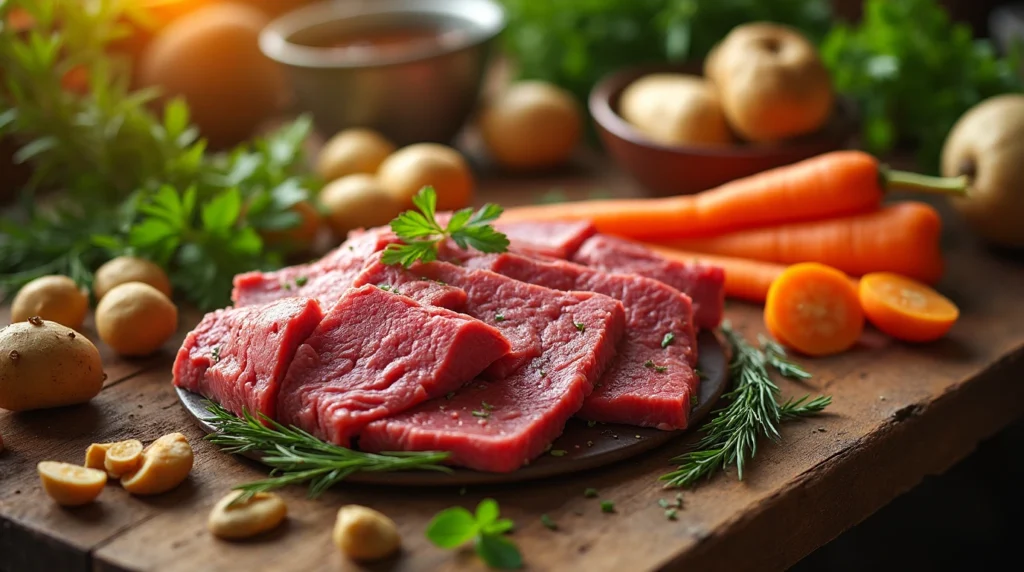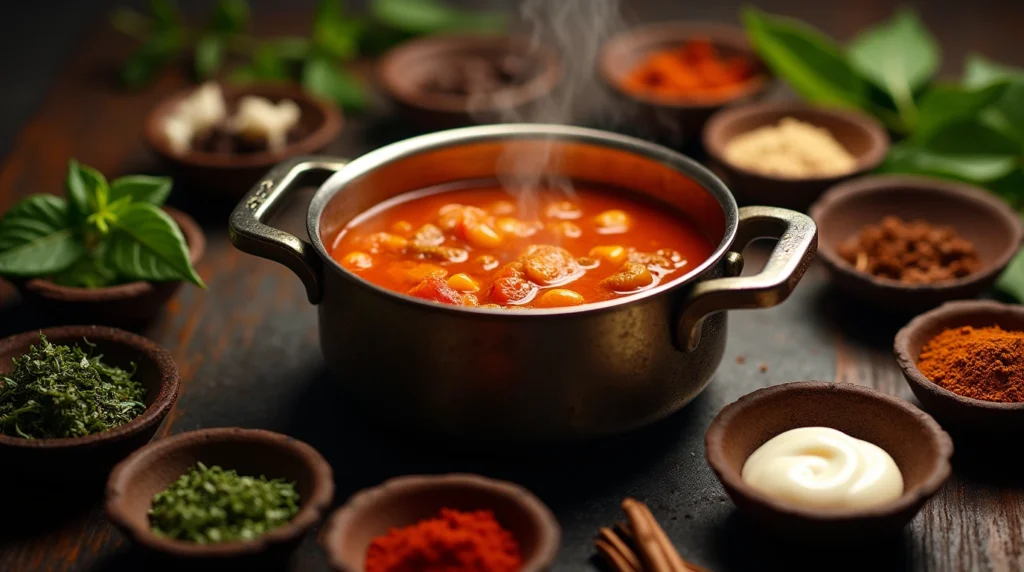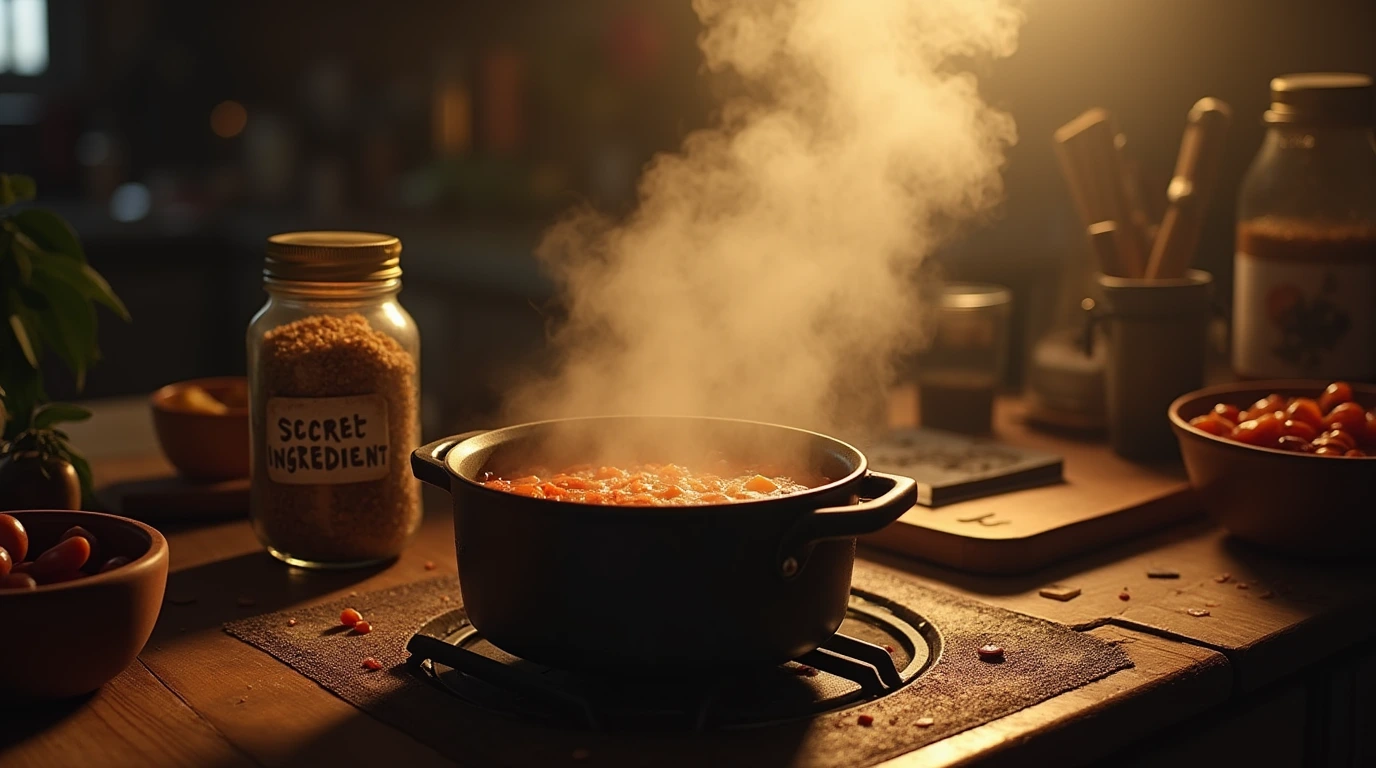Making a miracle stew recipe is more than just following a recipe. It’s about blending quality ingredients and techniques. This way, you can turn a good stew into an amazing one. It will warm your heart and taste buds. so What is the secret ingredient in a stew?
With an average rating of 5.0 based on 1 review for the Perfect Beef Stew recipe, it’s clear that the right approach makes all the difference.
In this article, we’ll share tips from culinary experts. They’ll talk about searing meat, seasoning, and adding herbs for flavor. You’ll learn how to make your beef stew recipe a hit with your family and friends.
The Role of Ingredients in Beef Stew
The success of beef stew depends on the ingredients chosen. Quality meat is key, affecting both taste and texture. Cuts like chuck roast or bone-in short ribs are best for their marbling. This adds flavor and keeps the meat tender.
The Importance of Quality Meat
Quality meat is the base of a great beef stew. Chuck is a top choice because it’s affordable and full of connective tissue. This fat melts during cooking, making the meat tender.
Prime steaks, while tempting, can become tough and dry in stew. It’s crucial to pick cuts with the right marbling for the best flavor.
Choosing the Right Vegetables
Vegetables add flavor and nutrition to beef stew. Onions, celery, carrots, leeks, and garlic bring depth and aroma. Colorful veggies add variety in texture and taste.
For extra heartiness, potatoes or beans can be added. These choices make the stew richer. Using the best vegetables is key to a satisfying stew.

What Is the Secret Ingredient in a Stew?
The secret to a great stew isn’t just about the ingredients. It’s also about the cooking techniques. Learning to enhance flavors can make any stew a hit. Key steps include searing meat and using the right seasoning.
The Impact of Searing on Flavor
Searing meat is crucial for flavor in a stew. It starts the Maillard reaction, creating a brown crust with deep flavors. For a stew, browning beef is key. It makes a savory base, called fond, that adds depth to the dish.
Adequate Seasoning Techniques
Seasoning is key to a balanced dish. Using salt and spices at different cooking stages builds flavor layers. Season the meat before searing and adjust as it simmers. This way, every part of the stew tastes great, making the meal more enjoyable.
Techniques for Achieving Rich Flavor
Creating a rich stew requires special techniques. These methods boost the taste and add complexity. Learning to layer flavors and browning meat are key steps.
Layering Flavors During Cooking
Layering flavors is crucial for a great stew. Begin with quality ingredients like onions, carrots, and celery. They form a strong flavor base.
As you cook, add more elements like roasted garlic and dried mushrooms. This slow addition lets each flavor shine. Spices should go in early to blend well with the stew.
The Role of Browning Meat
Browning meat is vital for flavor. It creates a golden crust that keeps moisture in. This crust is the foundation of the stew’s taste.
Sear the meat in batches to avoid crowding. Then, deglaze the pan to get all the tasty bits. Using homemade broth adds to the stew’s richness.
Let the stew simmer for at least two hours. This time allows the flavors to meld, making the stew satisfying.
It’s important to taste the stew while cooking. Adjust the seasoning with different salts or add fresh herbs like parsley or tarragon. These touches can make the stew even better.
The outcome of these techniques is a stew full of flavor. It shows the importance of careful cooking in enhancing taste.
How to Ensure Tender Meat
To get tender meat in stew, pick the right cuts of beef and use the best cooking methods. These steps make your stew better and more enjoyable to eat.
Selecting the Right Cuts of Beef
Choosing the right cuts of beef is key for a good stew. Cuts like bottom roast, chuck, and brisket work well because they have lots of connective tissues. These tissues break down when cooked, making the meat tender.
Let the meat sit at room temperature for about 30 minutes before cooking. This helps it cook evenly.
Slow Cooking vs. Instant Cooking
How you cook the meat affects its tenderness. Slow cooking, like braising at 284°F to 320°F for four to six hours, makes the meat tender and flavors deep. Instant cooking, like pressure cooking, can also make meat tender if done right.
Before cooking, sear the meat. This step adds flavor and makes the stew taste richer.
| Cooking Method | Ideal Temperature | Time Required | Tenderness Outcome |
|---|---|---|---|
| Slow Cooking | 284°F – 320°F | 4 to 6 hours | Very tender |
| Pressure Cooking | Varies (High Pressure) | 1 to 2 hours | Tender if done correctly |
Enhancing Umami in Stews
Umami flavors are key to a satisfying stew. Adding certain ingredients can greatly improve the taste. These ingredients are crucial for a hearty beef stew.
Key Umami Ingredients to Include
For a better umami flavor, use shiitake mushrooms, tomato paste, and anchovies. Shiitake mushrooms add depth, and tomato paste brings a savory taste. Anchovies, even though they’re fishy, add a surprising flavor boost.
Use two anchovies for every five pounds of beef. This ensures the best flavor.
Importance of Wine and Broth
Wine is vital in beef stew. A good dry red wine, like Cabernet Sauvignon or Merlot, adds complexity. Mixing it with a strong broth makes the stew even better.
Choose a rich beef broth or homemade vegetable stock. This liquid base helps all flavors come together. It makes every bite a delight.
| Ingredient | Description | Umami Contribution |
|---|---|---|
| Shiitake Mushrooms | Earthy flavor with a meaty texture. | High |
| Tomato Paste | Concentrated flavor enhancer. | Medium |
| Anchovies | Salty, savory depth; use oil-packed for best results. | High |
| Dry Red Wine | Adds acidity and complexity. | Medium |
| Beef Broth | Rich base for the stew. | High |
Additions That Transform Your Stew
In the world of stews, small additions can make a big difference. Focus on herbs and spices that enhance flavor and create layers of taste. This section highlights key elements that can turn a simple beef stew into a memorable dish.

Herbs and Spices to Elevate Flavor
Using fresh herbs like thyme and bay leaves can truly transform a beef stew. These herbs and spices for stew add aromatic qualities that make your dish fresh and deep. They complement the beef’s robust flavors and enhance the stew’s overall taste.
Dried herbs can also intensify flavors during cooking. They release oils and compounds that add to the dish. Mixing fresh and dried herbs can create a balanced flavor experience.
The Benefits of Using Tomato Paste
Adding tomato paste in stew greatly enhances the stew’s complexity. It adds a rich color and acidity that balances flavors. Tomato paste deepens the flavors and thickens the stew, making it heartier.
Using tomato paste in moderation is key to achieving a balanced flavor in any beef stew.
| Ingredient | Flavor Contribution |
|---|---|
| Thyme | Aromatic, earthy |
| Bay Leaves | Subtle floral notes |
| Tomato Paste | Richness, acidity |
| Red Wine | Depth, complexity |
| Parsley | Freshness, brightness |
The right mix of these enhancements can create a satisfying stew. It’s not just about filling your belly but also delighting your senses. Choosing and timing these flavor boosters is crucial for the ultimate stew experience.
Vegetable Selection for Maximum Flavor
The success of a delicious stew depends on choosing the right vegetables. The right mix of vegetables can make the stew taste better, feel better in your mouth, and look great. Root vegetables and seasonal ingredients are key to a satisfying stew.
Root Vegetables: The Perfect Base
Root vegetables are a great base for any stew. Carrots, parsnips, and Yukon Gold potatoes add sweetness and a thick texture. They soak up flavors well, blending with other ingredients as they cook.
It takes about 40 minutes for root vegetables to get tender. This time helps them keep their flavor and texture. They’re also packed with nutrients, making the stew comforting and nutritious.
Seasonal Vegetables for Variety
Adding seasonal vegetables to stews brings freshness and variety. Bell peppers or green beans add a nice crunch and color. Using seasonal ingredients boosts flavor and supports local farmers.
Fresh vegetables make each bite full of flavor. A mix of vegetables makes the stew look good and taste even better.
Cooking Method Revealed
Choosing the right cooking method for stew can really change how it tastes and feels. You can go for stovetop stew or oven cooking. Each way has its own benefits, fitting different cooking styles and schedules.
Stovetop cooking lets you keep an eye on your stew. This makes it easy to tweak flavors and texture as it cooks. It usually takes at least an hour and a half, letting all the flavors mix well.
Stovetop vs. Oven Cooking
Stovetop stew lets you be more hands-on. You can sear the meat first or simmer it for a long time. High heat is best for searing meats like veal, beef, or pork, boosting flavor and texture.
Oven cooking, on the other hand, spreads heat evenly. This makes sure your stew cooks consistently. It’s great for recipes that need a long, steady cooking time to get richer.
Using Slow Cookers Effectively
Slow cooker beef stew is perfect for busy people. Just mix in ingredients like onion, celery, and potatoes, and let it cook. Using 2 pounds of veal, 5 potatoes, and half a glass of red wine makes a tasty meal with little effort.
This method lets the flavors blend beautifully, creating a rich, umami dish. Slow cooker stew makes cooking easy for everyone.
Miracle Stew Recipe Inspiration
Creating the perfect stew is like a culinary adventure. The miracle stew recipe inspires you to try new ingredient combinations. This can turn a simple stew into something amazing.
Ingredient Combinations to Try
Some ingredients pair well together. For example, beef chuck roast with parsnips and shiitake mushrooms creates a rich flavor. Here are some other great combinations:
| Meat | Vegetables | Herbs & Spices |
|---|---|---|
| Beef Chuck Roast | Carrots | Fresh Thyme |
| Pork Shoulder | Potatoes | Garlic |
| Lamb Shanks | Onions | Bay Leaves |
| Chicken Thighs | Celery | Rosemary |
Adapting Recipes for Personal Taste
Adapting stew recipes lets you make it your own. You can swap out veggies or add spices to match your taste. If you prefer a thicker stew, try using flour or cornstarch instead of tapioca. This way, you can find flavors that you love, making the stew even more enjoyable.
Conclusion
Making a delicious stew is more than just mixing ingredients. It’s about knowing how each part adds to the dish. Choosing top-notch beef and fresh veggies is key. Also, techniques like searing and seasoning make a big difference in taste.
Adding ingredients that boost umami and using the right cooking methods are crucial. This way, your stew will be incredibly satisfying.
Beef stew cooking usually takes about three hours. This slow cooking makes the beef tender and the flavors blend perfectly. Each serving is packed with 58 grams of protein and rich flavors from herbs and spices.
When done well, stew becomes more than just food. It’s a comfort that brings people together. By mastering these techniques, you can make a stew that delights and leaves a lasting impression.
So, by following these steps, you’re not just cooking. You’re creating a warm, inviting experience. One that everyone will want to enjoy again and again.
FAQ
What is the secret ingredient in a stew?
The secret ingredient isn’t just one thing. It’s about using great cooking techniques and quality ingredients. These help make the stew’s flavor richer and deeper.
How can I achieve tender meat in my beef stew?
Choose the right beef cuts, like bone-in short ribs or chuck roast. Slow cooking breaks down tough tissues, making the meat tender.
What vegetables are best for beef stew?
Use fresh veggies like carrots, parsnips, onions, and garlic. They add flavor and nutrients. Root veggies like carrots also add sweetness and bulk.
How important is searing meat before stewing?
Searing is key. It creates deep flavors through the Maillard reaction. This makes a savory base, or fond, that enriches the stew.
What are some good umami ingredients to enhance my stew?
Shiitake mushrooms, tomato paste, and rich beef broth boost umami in your stew.
Can I use wine in my beef stew, and why?
Yes, a dry red wine like Cabernet Sauvignon or Merlot adds depth and complexity to your stew.
What herbs and spices should I use to elevate the flavor?
Use fresh herbs like thyme and bay leaves, and various spices. They enhance the stew’s taste.
How do I make a miracle stew recipe?
Mix unique ingredients, like beef with parsnips and shiitake mushrooms. Personalize it to your liking.
What cooking methods can I use for making beef stew?
Try stovetop cooking for control, oven cooking for even heat, or slow cookers for convenience. This lets flavors develop slowly.
Why are seasonal vegetables important in a stew?
Seasonal veggies add variety and freshness. They also boost flavor, making each stew bite more complex.

